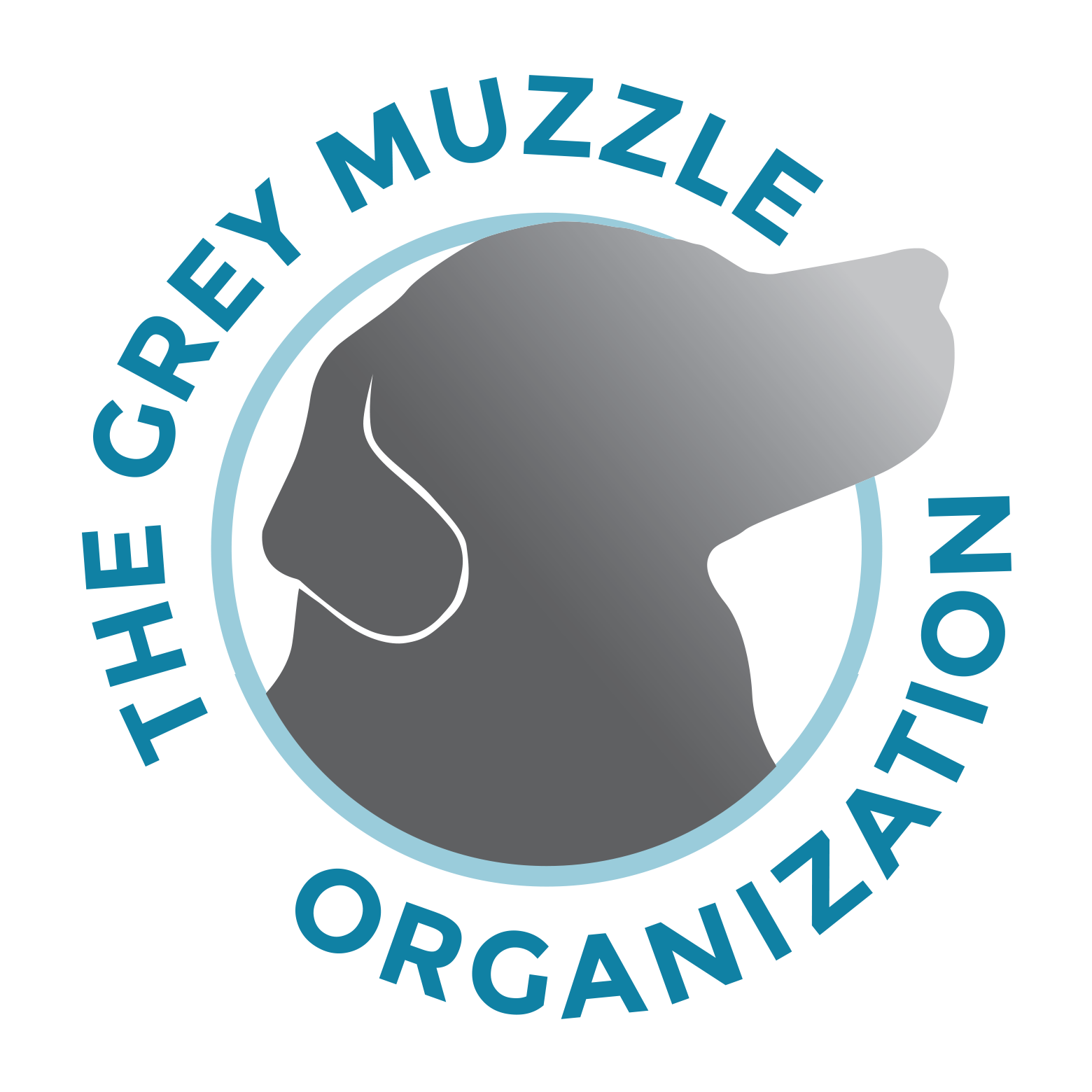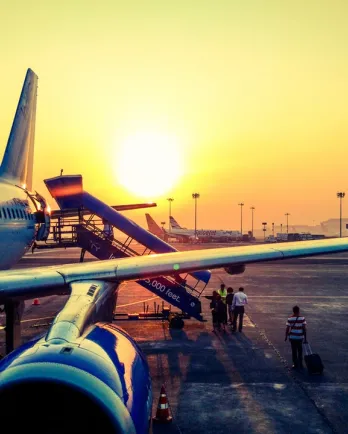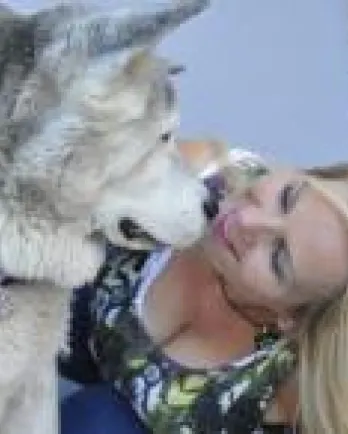Keeping Your Senior Dog Safe on Planes & in Airports By Denise Fleck, The Pet Safety Crusader™
Recently, a member of The Grey Muzzle family, encountered two separate instances of dogs fighting while travelling. According to our Vice-President Jessica Rothfuss:
One fight occurred on the plane during boarding while the other happened in the airport. A small dog had a carrier but was not really in it as it was unzipped. The dog barked and carried on whenever it saw another dog and got into a fight with a larger leashed dog. The on-board fight also occurred with an on- leash dog. It was unclear if any of the canines were emotional support as none were wearing vests or any ID to indicate they were in fact, service animals.
Travelling with any pet can be a challenge at best, but some may feel senior dogs already know their manners and are desensitized to external stimuli simply from their years on the planet. Many senior dogs however, are more susceptible to stress and may have waning vision as well as hearing loss, that can cause them to become alarmed by sudden movements, people, other animals and vibrations that they didn’t hear or see coming their way. Additionally, although there is still a lot of life in a senior best friend, your older fella or lady may be on medications and ailing from issues that could compromise their ability to be in tight quarters or experience changes in pressure.
An excerpt from my book, The Dog Safety Bible, shares basic tips for airline travel with dogs of any age, but read all the way through to hear what expert trainers suggest to prepare your pooch and you for safely flying into the wild blue yonder:
If you need to get there fast, a plane may be your choice of transport. Check with the various commercial carriers for their rules and regulations to see which can best accommodate your dog on board. Air Hollywood’s K9 Flight School prepares people and pets to travel confidently and comfortably by providing valuable information and training in an immersive aviation environment. It might be good to give this a try before emBARKing on the real thing!
If your dog must fly, here are some considerations to increase the chances of a safe flight:
- Familiarize him with his travel carrier weeks before the flight and don’t forget a pre-travel veterinary visit.
- Clip nails so that they can’t catch on carrier doors, and make sure the collar alsocannot catch on anything.
- Don’t feed for 4-6 hours prior to air travel. Place ice cubes in the tray attached to the inside of the crate. Water will spill.
- Once through security it will be hours before a potty break, so exercise beforehand.
- Book only direct flights and chose early morning/late evening flights during the hot months and afternoon flights during the colder times of year. Avoid holiday chaos at all costs for your pet’s sake.
- Travel on the same flight (if your dog is in the cargo hold) and watch your dog being loaded and unloaded.
- Let the captain and flight attendants know your dog is traveling in the cargo hold.
- Label the carrier with your name, permanent address and telephone number, final destination, and where you or a contact person can be reached as soon as the flight arrives.
- Upon arrival, open the carrier as soon as you are in a safe place and should anything seem not quite right, high tail it to a Veterinarian.
The Humane Society warns that riding underneath a plane could expose animals to temperature extremes, poor ventilation and rough handling. Unless your Veterinarian advises differently, NEVER fly flat-snouted dogs including Pugs, Pekingese and Chow Chows in the cargo hold. These breeds have short nasal passages that leave them vulnerable to oxygen deprivation and heat stroke.
The Facts
According to the Federal Aviation Administration (FAA), each airline can make the determination as to whether your pet can travel in the passenger cabin. If you are permitted, your pet contained will be considered carry-on baggage and must abide by all carry-on baggage rules including:
- Your pet container must be small enough to fit underneath the seat without blocking any person's path to the main aisle of the airplane.
- Your pet container must be stowed properly before the last passenger entry door to the airplane is closed in order for the airplane to leave the gate.
- Your pet container must remain properly stowed the entire time the airplane is moving on the airport surface, and for take-off and landing.
- You must follow flight attendant instructions regarding the proper stowage of your pet container.
Additionally, you must follow all FAA regulations as well as the airlines additional procedures, which could entail:
- A limited list of the types of pets that you can bring into the cabin
- A limit on the number of pets in the cabin
- A limit on the number of pets that may accompany you on the airplane
- A requirement that your pet be harmless, inoffensive and odorless
- A requirement that your pet remain in the container for the entire flight
- A requirement that you be able to produce a recently issued health certificate for your pet
Dogs who travel in the cabin of an airplane must be in a carrier that fits underneath the seat in front of their human travel companion. They must stay inside that carrier for the duration of the flight. Larger dogs cannot be accommodated in the plane cabin unless they are a support or service dog and will stay at their handler’s feet. Otherwise, larger dogs must travel as cargo in their crates. Obviously, check with the individual airline as protocol not only varies but also changes. Delta, for instance, no longer accepts dogs in crates larger than a #300 (32” X 22.5” X 24” high). It is up to YOU to obtain the current 4-1-1 for your dog’s sake!
“Emotional Support Animals and Service Dogs are not required to wear any identification to indicate their ‘jobs.’ Websites that offer certification, vests, ID cards, etc. are often scams,” according to Cyndy Wood, CPDT-KA of Sit Stay Good Dawg Training in Burbank, California. “The main difference between the tasks performed is that an Emotional Support Animal requires no training while a Service Dog must be trained to perform a specific task(s) to support the handler.”
Trainer Jen Freilich, IACP-CDT of At The End of Your Leash in Riverside, California, is passionate about this topic. She says, “I have a real problem with Emotional Support Animals (ESAs) and their lack of training. This is obviously a very real problem as demonstrated by the alarming number of bites. I firmly believe that all ESAs should be trained to, at the very least, a Canine Good Citizen (CGC), Urban Canine Good Citizen (CGCU) and/or Advanced Canine Good Citizen (CGCA) level.”
What YOU Can Do
1. Train Your Dog
To keep your traveling dog safe, make sure he or she is properly trained. At an airport or in the air, dogs will experience large numbers of people, unfamiliar sounds and vibrations as well as confined space. For his safety and that of others, your dog needs to be able to perform specific behaviors in a variety of situations. Says Joan Hunter-Mayer, CBCC-KA/CPDT-KA of The Inquisitive Canine in Santa Barbara, California, “These behaviors need to be proofed around a lot of different distractions. If you're planning travel on a plane, then do all you can to organize dress rehearsals by taking them to an airport.” Mayer also suggests, “Walking around, getting your dog used to environmental triggers (sights, sounds, smells) can be helpful to prep for the actual time of travel.” This doesn’t mean you need to buy an extra plane ticket or try to get through security, but you can certainly park and walk around permissible areas.
2. Follow The Rules
Teoti Anderson, CPDT-KA, KPA-CTP, Vice-President of A Dog's Best Friend and Author of several books including, The Dog Behavior Problem Solver, Ultimate Guide to Dog Training, Puppy Care and Training explains, “If you’re taking your dog on a plane, there are precautions you need to take to ensure your canine friend makes it to your destination safe and sound. Airlines are getting stricter about allowing dogs on planes, even emotional support animals, and unfortunately, there are people who take advantage of the Americans with Disabilities Act. There is no certification required for service animals or emotional support animals. People take advantage of this and label their dogs as emotional support animals, even though the dogs may not have the temperament or training to back it up. Sure, the dog may sport a fancy ID purchased off the Internet, but that doesn’t mean anything, since no certification is required. So don’t assume when you see a dog on a plane that he’s going to be well trained. Keep your distance as a precaution.”
Anderson adds, “If the airline states you have to keep your dog in a carrier, do so. Keep it shut. You don’t want your dog to get out and run amok around the airport. You also don’t want a child to reach in to try and pet your dog – or an adult, for that matter! Travel can be stressful for dogs and your dog may not be as accommodating of a stranger reaching into his carrier as he might be otherwise. If your dog is not used to traveling in a carrier, definitely train him to love his carrier well before your trip.”
In the situation described above, Wood shares, “The smaller dog’s carrier should have been zipped all the way, especially since the dog was displaying reactive behavior. It was the handler’s responsibility to keep the dog contained.” A potential Service Dog would flunk out of training if it exhibited that type of behavior.
3) Know Your Dog & Pay Attention to His Signals
While you need to be ready for other dogs or people causing an issue, it might not hurt to look in the mirror as well. Is your dog well behaved in the airport? Does he bark at everyone who walks by? Does he growl at other dogs? Will he hold his bladder and bowels until you get him to a relief area, or is he likely to lift a leg in the airport waiting area? Says Anderson, “If your dog has issues, don’t be in denial. Just get some help and train him.”
Also, understand your dog’s body language and know what behaviors your best pal displays when he is getting stressed and reaching his threshold. Wood urges, “Handlers must pay attention to their dog’s stress levels. Especially during boarding or once on the plane, dogs will be in tight quarters for a significant amount of time which can create anxiety and cause the calmest pooch to lash out. Travelling dogs should be on a short leash, held close to the handler, and the handler must stay vigilant and aware of any approaching dogs.”
Like in most scenarios where accidents happen, we have set our dog up for disaster through improper handling or training or lack of attention. If you must travel your senior dog (or any aged dog), practice, train and do both some more. Personally, being a large dog parent, I would never fly my senior dog since he or she would have to fly cargo. I have read too many horror stories and have heard of dogs being damaged mentally and physically. There are just too many changes for something to go wrong with delays, shifting cargo, temperature fluctuations, extreme noise and more. I agree with Freilich who says, “I would drive the senior across country, but that’s me!”
Known as The Pet Safety Crusader™, Denise has personally taught more than 15,000 humans animal life-saving skills and has appeared on Animal Planet’s Groomer Has It and Pit Boss, A&E’s Kirstie Alley’s Big Life, CBS-TV’s The Doctors, CNN Headline News, PBS-TV’s Lassie’s Pet Vet and KTLA Los Angeles as well as on radio and in magazines.
She is currently the President of Grey Muzzle's Board of Directors. You can read more about her here.




